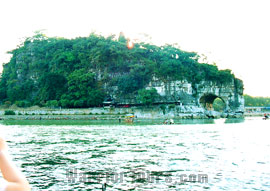Elephant Trunk Hill & Ling Canal

![]() Elephant Trunk Hill
Elephant Trunk Hill
Situated on the western bank of the Li River in the southeastern part of the city, Elephant Trunk Hill is a landmark of Guilin.
The hill got its name because of its appearance resembling a huge elephant drinking at the riverside with its long trunk. With an elevation of about 200 meters (660 feet), the hill was the result of limestone deposits left around 3.6 million years ago. Between the trunk and the legs of the elephant, there is a round cave running through the hill from north to south. It looks like a moon floating on the water, hence the name Water-Moon Cave. On a fine evening, the cave with the waving waters gleaming under the moonlight creates a spectacular scene of 'three moons': the water-moon cave, the moon in the sky and the moon reflected on the water. A pavilion was built in the cave where poets gathered and now on the cliff in and around the cave are numerous poets' inscriptions from past dynasties.
Walking out of Water-Moon Cave, you will find a flight of steps ascending to the elephant's 'eye' at the southern hillside. The 'eye' is actually a 2-meter-high (7 feet) , 20-meter-long (66 feet) cave that goes through the hill from south to north. It is called 'Elephant Eyes Cave'. The 'eye' on the northern hillside is inaccessible. The cave offers excellent views of the Li River. Leaving the 'eye', the steps continue to the top of the hill where a Tibetan-style stupa stands. It dates from the Ming Dynasty (1368 - 1644) and is called Puxian Pagoda.
| Admission Fee: | CNY 20 |
| Opening Hours: | 08:30 to 16:30 |
| Recommended Time for a Visit: |
Half an hour |
| Bus Route: | 2 |
Ling Canal, an ancient water conservancy project from the Qin Dynasty (221 B.C.-206 B.C.), is boasted to be the earliest canal in the world.
Ling Canal was originally built to connect the water systems of the Yangtze River and Pearl River. In 221 B.C., Ying Zheng, the first emperor in China's history unified the country after defeating other six warring states of Chu, Zhao, Qi, Yan, Wei and Han. The emperor's ambition was blocked by the endless mountain ranges to the south of the Yangtze River when his troops went down further southward to the area in today's Guangxi Province. The only way was to build a canal, which could connect the river systems in the Yangtze Region and Pearl River Region and provide the water transportation for the troops. Consequently, Ling Canal was constructed. In the past 200 years, the canal has played an important role in water transportation and agricultural irrigations in this region.
Located in Xing'an County, 57 kilometers (35.4 miles) away from Guilin City, this ancient project was firstly built in 214 B.C. The project construction has been elaborately designed with the main dams, the northern and southern canals, Huazui (diversion dykes), sluice gates and Dou Men.
Solid wood columns were placed vertically and horizontally at the bottom of the river and were tamped to form the solid foundation of the dam. Then huge stone slabs closely connected with iron rivets were added onto the foundation. The integration of wood, stones and iron knots has made the dam standing through both the floods and ages. In some shoal sections or deep ravines, which were very difficult for ships to go through, a unique structure called Dou Men was constructed. Dou Men is actually something like today's ship lock which could lift up or drop down the water surface in different sections to the same level by opening or closing the 'gate'. Then, the ship could pass it very easily. There unique structures are considered to be 'Father of Ship Locks'in the world.

